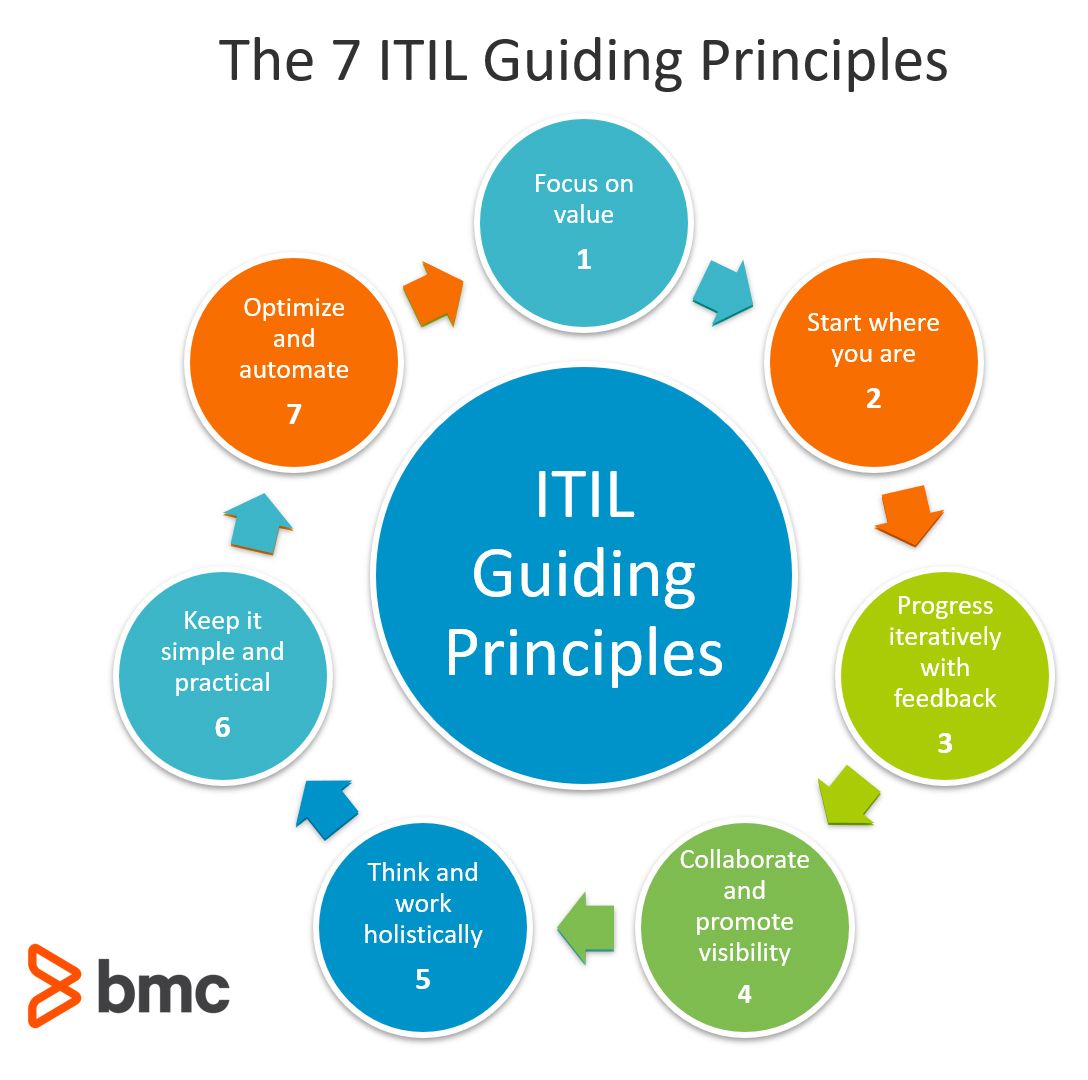One of the most important components of the ITIL Service Value System is the ITIL Guiding Principles. A guiding principle is a recommendation that provides universal and enduring guidance to an organization, which applies in all circumstances, regardless of changes in its goals, strategies, type of work, or management structure. The 7 ITIL Guiding Principles are an adaptation of the 9 Guiding Principles defined in 2016’s ITIL Practitioner course. They embody the core messages of ITIL, and of service management in general, supporting successful actions and good decisions of all types and at all levels.
Download Now: ITIL 4 Best Practice e-Books
These all-new for 2020 ITIL e-books highlight important elements of ITIL 4 best practices. Quickly understand key changes and actionable concepts, written by ITIL 4 contributors.
The 7 ITIL Guiding Principles are as follows:
- Focus on value
- Start where you are
- Progress iteratively with feedback
- Collaborate and promote visibility
- Think and work holistically
- Keep it simple and practical
- Optimize and automate

The guiding principles are universally applicable to practically any initiative, any size of organization or type of service provider and to all relationships with stakeholder groups. They can therefore be adopted and adapted to suit any service management improvement, and are the “how” that can guide organizations in their work regardless of their own specific needs and circumstances.
The ITIL guiding principles are reflected in other frameworks and standards such as Agile, DevOps, Lean and COBIT. Agile is a timeboxed, flexible, and adaptive approach to IT work that allows for a rapid response to change, while promoting autonomy in development teams and close collaboration with customers. DevOps concentrates on the process of delivering software to live environments, with a focus on unifying technical operations and development. Agile shares many common themes with ITIL, as can be seen by the mapping of ITIL guiding principles to the Agile Manifesto.
| Agile Manifesto – We Value: | ITIL Guiding Principles |
|---|---|
| Individuals and interactions over processes and tools | Keep it simple and practical Start where you are |
| Customer collaboration over contract negotiation | Focus on value Collaborate and promote visibility |
| Responding to change over following a plan | Progress iteratively with feedback Keep it simple and practical |
Let’s look at the ITIL guiding principles in detail. Note that all the guiding principles interact with and depend upon each other, therefore organizations should not use just one or two of the principles, but should consider the relevance of each of them and how they apply together.
1. Focus on value
Everything the organization does should link back, directly or indirectly, to value for itself, its customers, and other stakeholders. When focusing on value, the first step is to know who are the customers and key stakeholders being served. Next, it is important to have an understanding of what consitutes value from the consumer’s perspective. Finally, it is critical to understand the customer’s experience with the service and the organization as a whole through a clear awareness of the customer experience (CX) or user experience (UX). CX can be defined as the entirety of the interactions a customer has with an organization and its products, and therefore is both objective and subjective.
To apply this principle successfully, consider this advice:
- Know how service consumers use each service.
- Encourage a focus on value among all staff.
- Focus on value during normal operational activity as well as during improvement initiatives.
- Include a focus on value in every step of any improvement initiative.
2. Start where you are
When undertaking an improvement opportunity, it is not necessary or wise to remove what has been done in the past and build something completely new, as this can be wasteful in terms of time and/or cost as well as lost opportunity to leverage of what exists. Do not start over without first considering what is already available to be leveraged.
Services and methods already in place should be measured and/or observed directly to properly understand their current state and what can be re-used from them. Decisions on how to proceed should be based on information that is as accurate as possible. However, measurement should be used to support the analysis of what has been observed rather than to replace it, as over-reliance on data analytics and reporting can unintentionally introduce biases and risks in decision-making.
To apply this principle successfully, consider this advice:
- Look at what exists as objectively as possible, using the customer or the desired outcome as the starting point.
- When examples of successful practices or services are found in the current state, determine if and how these can be replicated or expanded upon to achieve the desired state.
- Apply your risk management skills.
- Recognize that sometimes nothing from the current state can be re-used.
3. Progress iteratively with feedback
Resist the temptation to do everything at once. By organizing work into smaller, manageable sections (iterations) that can be executed and completed in a timely manner, the focus on each effort will be sharper and easier to maintain. However, the overall initiative as well as its component iterations must be continually re-evaluated and potentially revised to reflect any changes in circumstances and ensure that the focus on value has not been lost. Seeking and using feedback before, during and after each iteration will ensure that actions are focused and appropriate, even in changing circumstances. Once received, feedback can be analyzed to identify improvement opportunities, risks, and issues.
To apply this principle successfully, consider this advice:
- Comprehend the whole, but do something.
- The ecosystem is constantly changing, so feedback is essential.
- Fast does not mean incomplete.
4. Collaborate and promote visibility
When initiatives involve the right people in the correct roles, efforts benefit from better buy-in, more relevance (because better information is available for decision-making) and increased likelihood of long-term success. Inclusion is generally a better policy than exclusion (silo activity) since creative solutions, enthusiastic contributions, and important perspectives can be obtained from unexpected sources. Working together in a way that leads to real accomplishment requires information, understanding, and trust.
The first important step is identifying and managing all the stakeholder groups that an organization deals with. The first and most obvious stakeholder group is the customers, as in service management the organization’s main goal is to facilitate customer outcomes. Other examples of stakeholder collaboration include:
- Developers working with other internal teams
- Suppliers collaborating with the organization
- Relationship managers collaborating with service consumers
- Customers collaborating with each other
- Internal and external suppliers collaborating with each other
The contribution to improvement of each stakeholder group at each level should be understood, as should the most effective methods to engage with them. Depending on the service and the relationship between the service provider and the service consumer, the expectations about the level and type of collaboration can vary significantly. It is important to involve stakeholders, and address their needs at all levels. Determining the type, method, and frequency of such messaging is one of the central activities related to communication.
When stakeholders have poor visibility of the workload and progression of work, there is a risk of creating the impression that the work is not a priority. Insufficient visibility of work leads to poor decision-making, which in turn impacts the organization’s ability to improve internal capabilities. To avoid this, the organization needs to perform such critical analysis activities as understanding the flow of work in progress, identifying bottlenecks and excess capacity, and uncovering waste.
To apply this principle successfully, consider this advice:
- Collaboration does not mean consensus
- Communicate in a way the audience can hear
- Decisions can only be made on visible data
5. Think and work holistically
No service, practice, process, department, or supplier stands alone. The outputs that the organization delivers to itself, its customers, and other stakeholders will suffer unless it works in an integrated way to handle its activities as a whole, rather than as separate parts.
Taking a holistic approach to service management includes establishing an understanding of how all the parts of an organization work together in an integrated way (remember the four dimensions of service management?), including having an end-to-end visibility of how demand is captured and translated into outcomes. In a complex system, the alteration of one element can impact others and, where possible, these impacts need to be identified, analysed and planned for.
To apply this principle successfully, consider this advice:
- Recognize the complexity of the systems
- Collaboration is key to thinking and working holistically
- Where possible, look for patterns in the needs of and interactions between system elements
- Automation can facilitate working holistically
6. Keep it simple and practical
Always use the minimum number of steps to accomplish an objective. Outcome-based thinking should be used to produce practical solutions that deliver valuable outcomes. If a process, service, action or metric fails to provide value or produce a useful outcome, then eliminate it. Trying to provide a solution for every exception will often lead to over-complication. Instead, rules should be designed that can be used to handle exceptions generally.
Critical to keeping service management simple and practical is understanding exactly how something contributes to value creation. For example, work involving regulatory compliance may not seem important to service teams dealing with customer issues. It is necessary to establish and communicate a holistic view of the organization’s work so that individual teams or groups can understand how their work is being influenced by, and in turn influences, others.
When designing, managing, or operating practices, be mindful of conflicting objectives. For example, managers may want a lot of data, but service teams might be constrained in prioritizing the collection of that data. It is important that the organization agrees on a balance between its competing objectives.
To apply this principle successfully, consider this advice:
- Ensure value
- Simplicity is the ultimate sophistication
- Do fewer things, but do them better
- Respect the time of the people involved
- Easier to understand, more likely to adopt
- Simplicity is the best route to achieving quick wins
7. Optimize and automate
Organizations must maximize the value of the work carried out by their human and technical resources. Technology can help organizations to scale up and take on frequent and repetitive tasks, allowing human resources to be used for more complex decision-making. A new generation of cognitive tools is further broadening these opportunities. However, technology should not always be relied upon without the capability of human intervention, as automation for automation’s sake can increase costs and reduce organizational robustness and resilience.
Optimization means to make something as effective and useful as it needs to be. Before an activity can be effectively automated, it should be optimized to whatever degree is possible and reasonable. It is essential that limits are set on the optimization of services and practices, as they exist within a set of constraints e.g. financial, compliance, time or resources.
There are many ways in which practices and services can be optimized. Regardless of the specific techniques, the path to optimization follows these high-level steps:
- Understand and agree the context in which the proposed optimization exists
- Assess the current state of the proposed optimization
- Agree what the future state and priorities of the organization should be, focusing on simplification and value
- Ensure the optimization has the appropriate level of stakeholder engagement and commitment
- Execute the improvements in an iterative way
- Continually monitor the impact of optimization
Automation typically refers to the use of technology to perform a step or series of steps correctly and consistently with limited or no human intervention. In its simplest form, however, automation could also mean the standardization and streamlining of manual tasks, such as defining the rules of part of a process to allow decisions to be made ‘automatically’. Efficiency can be greatly increased by reducing the need for human involvement to stop and evaluate each part of a process. This includes saving the organization costs, reducing human error, and improving employee experience.
To apply this principle successfully, consider this advice:
- Simplify and/or optimize before automating
- Use automation to reduce toil: tasks which are manual, tactical, devoid of enduring value and/or linearly scaling
- Define your metrics
- Use the other guiding principles when applying this one
ITIL® is a registered trade mark of AXELOS Limited. IT Infrastructure Library® is a registered trade mark of AXELOS Limited.







